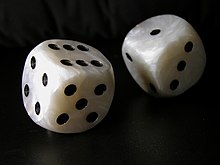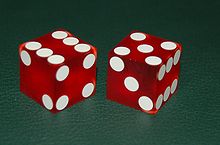dice game







A game of dice is a game of chance that essentially consists of achieving a certain result with one or more game dice . Combinatorial skills are sometimes required on the part of the player (s).
Many dice games are suitable as an application of the calculus of probability . The most widespread are six-sided cube, wherein each side of the numerical value in the form of eyes (engl. Pips is shown). There are also dice with other numbers of sides (4 to 40 sides and more) that are primarily used in role-playing games .
History of the game of dice
Origin of the dice game
Plato attributes the invention of the game of dice to the Egyptian god Thoth . According to the historian Pausanias , the Greek warrior Palamedes is the source of ideas. Herodotus, on the other hand, names the Lydians as the inventor of the dice game.
History of the game of dice by country and culture
- In ancient Egypt, the Orient, India and Greece, the game of dice was known very early on. In ancient Egypt there were, among other things, pyramid-shaped cubes.
- In Roman antiquity , dice games were widespread in all classes, although it was only officially allowed to play on the Saturnalia .
- Emperor Augustus is said to have been a passionate dice player.
- Tacitus reports on the Germanic peoples' passion for dice in his Germania . According to Tacitus, when they were sober, they played with extreme recklessness for house and yard, and ultimately for their own freedom.
- The addictive pastime was also often banned in the Middle Ages, around 1396 in Milan. An offender had to expect a 200 lire fine and then walk at least 100 miles from the city.
- In English game rooms around 1800 there were human dice swallowers whose task it was to swallow all dice quickly during raids . Craps were forbidden.
- Dice hot Arabic az-zahr , of which the name is derived Hasard game off, thus the dice game was considered the gambling per se, in the strict sense refers to hazard a specific, previously extremely popular dice game.
Pure dice games
Games with dice
- Play with a dice
- Pubic louse , double felt louse, combined felt louse
- Chase or race
- High house number , low house number and hidden house number
- Jule and mute Jule
- Cow tail and oxtail
- Dice lice
- Makao , Evil 9, Fifteen, Over 12 is dead
- Mariechen from the front , Mariechen from behind
- Pig , Evil One and Evil Three
- sultan
- Toto
- Super Six
- Zeppelin
- Twenty-two , fifteen
- Games with two dice
- Barbudi
- Craps , also Crabs , Craps shooting or Seven Eleven and the older Hazard
- Eleven up
- Espérance
- Happiness house
- Funny seven
- Mäxchen , also Mieren , Mäxle and Mexican (in the USA )
- Quinquenove
- Shut the box
- Games with three dice
- Banca francesa
- Chicago
- Chuck a luck
- Cee-lo
- Mini dice
- Paschen , also puzzles , knuckles , knockles or passe-dix
- Shock
- Sic Bo , also Dai Siu or Big and Small
- Games with five or more dice
- Yacht , Kniffel (also Yahtzee )
- Balut
- Sachsenkniffel
- Ten thousand
- The game
Games with poker dice
Poker dice originated in the USA around 1880 (there is a patent from 1881). Poker dice show the following six card symbols on the six faces: ace, king, queen, jack, ten and nine. The ace is opposite the nine, the king of ten and the queen opposite the jack.
The three fundamentally different forms of dice poker are
- Poker Dice or Open Dice Poker ,
- Liar Dice or Verdecktes Würfelpoker (French Poker Menteur ), and
- Escalero
Play with other special dice
- Astragaloi (historical dice game with bones)
- Fish, shrimp, cancer , see Chuck a Luck
- Bell and hammer
- Crown and anchor , see Chuck a Luck
- Phase 10 - dice
- Mess (with pig figures as dice)
- Two-up dice , see Two-up
Dice board games
- Royal game of Ur
- Senet
- Puff or Wurfzabel , Backgammon and its relatives Toccadille and Tric Trac
- Yut , Pachisi and their descendants: Parcheesi , Parchís , Chinese games , witch's dance , hurrying with a while , Jeu des petits chevaux , Ludo , don't get angry , catch your hat , maleficent
- Moksha Patamu , ladder game
- Goose play
- Rakado
- Shipka pass
- risk
- Phase 10 - The board game
Marked dice
Because profits can be made in the game of dice, fraudsters have tried to play with marked dice in the past. With proper, six-sided dice, every number is hit with the same probability, namely 1/6. Marked dice contain small inserts made of lead, so that e.g. B. a die preferably shows a six, a small piece of lead is embedded on the side of the one.
Modern precision cubes are therefore transparent, mostly made of cellulose acetate, and are manufactured with a tolerance of 1/1000 inch , i.e. 0.025 mm, using laser technology.
Corresponding countermeasures were already taken in ancient times: To prevent a player from bringing loaded dice into play, the dice were locked in a small cage. This is still the case with the Sic Bo casino game today , but dice boxes are also very practical for playing on the go.
Already in antiquity, marked dice according to Ineichen were the earliest evidence of a stochastic understanding, even if the first quantitative considerations about the chances of winning in games of chance did not follow until over a thousand years later.
Often, however, dice were very simply forged, so there are antique specimens with two sixes and a missing one - since you can never see the two opposite sides at the same time, this fraud easily goes undetected.
Unbalanced cubes
As didactic material that enables empirical experiments in stochastics lessons, play cubes with edges of unequal length, so-called Riemer cubes or Riemer cuboids , were suggested . Lego bricks serve the same purpose.
Dice cup
Aside from craps - in this game it is common to throw the dice by hand, but have to be thrown against a wall and bounce back - it is an unwritten rule that the dice should be shaken in a dice cup . The somewhat more elaborate dice cups have so-called lips on the inside so that the dice always jump when rolling out.
Dice tower
Another aid to ensure that the dice fall randomly and are not artfully placed by hand is the Roman turricula , the dice tower or engl. Baffle box .
Others
Juliane Werding had a chart placement in 1986 with the song Das Würfelspiel .
literature
- Harald Froschauer : Board and dice games as traditional leisure activities. In: Harald Froschauer, Hermann Harrauer: Game on the Nile. Entertainment in ancient Egypt (= Nilus. Studies on the culture of Egypt and the Middle East . Volume 10). Phoibos Verlag, Vienna 2004, ISBN 3-901232-57-5 .
- Ulrich Vogt : The die has been cast - 5000 years around the cube . Georg Olms Verlag, Hildesheim u. a. 2012, ISBN 978-3-487-08518-0 .
Web links
- Johann Werfring: Gamblers of antiquity . In: Wiener Zeitung. March 2, 2005.
Individual evidence
- ↑ Harald Froschauer: Board and dice games as traditional leisure activities. In: Harald Froschauer, Hermann Harrauer: Game on the Nile. Entertainment in ancient Egypt. (= Nilus. Studies on the culture of Egypt and the Middle East. Volume 10). Phoibos Verlag, Vienna 2004, ISBN 3-901232-57-5 , p. 30.
- ↑ H. Lüders: The dice game in ancient India. 1907. In: Treatises of the Royal Society of Sciences in Göttingen. Philological-historical class. New series Volume IX, No. 2. Berlin: Weidmannsche Buchhandlung Digitalisat (printed in: Philologica India. Selected small writings by Heinrich Lüders. Ceremony for his 70th birthday. Göttingen 1940, Vandenhoeck & Ruprecht)
- ^ Johann Werfring: Gamblers of antiquity. In: Wiener Zeitung. March 2, 2005.
- ↑ R. Ineichen: Dice and Probability. Stochastic thinking in ancient times. Spektrum Verlag, Berlin 1996, ISBN 3-8274-0071-6 .
- ^ Suetonius, De vita Caesarum, Augustus, 71.
- ^ Tacitus, Germania, 24, 3-4.
- ↑ R. Ineichen: Dice and Probability. Stochastic thinking in ancient times . Berlin, Spektrum Verlag 1996, ISBN 3-8274-0071-6 , pp. 58, 118, 131 f.
- ↑ A. Büchter, H.-W. Henn: Elements of stochastics . Springer Verlag, Berlin 2005, ISBN 3-540-22250-2 , p. 143. doi: 10.1007 / b138982
- ↑ W. Riemer: Stochastic problems from an elementary point of view . BI Wissenschaftsverlag, Mannheim 1991, ISBN 3-411-14791-1 , pp. 41 ff., 110 ff.
- ↑ Kinga Szőcs, Birgit Skorsetz: Riemer-Quader - Suggestions for the introduction to the concept of probability. Presentation slides. Erfurt 2015 .
- ^ Lambacher-Schweizer, Mathematics for High Schools Lower Saxony. Stuttgart, Leipzig: Ernst Klett Schulbuchverlage, 2006, p. 137
- ↑ curricula



